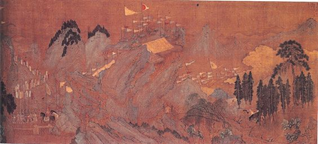Three artifacts connected to the fall of ancient China are the tomb of Emperor Qin Shi Huang Di, the silk hand scroll, and Xiang Yu’s tomb. The emperor’s tomb represented the beginning of the fall, the scroll represents the beginning of a new era that marked and Xiang Yu’s tomb absolute end of the Qin dynasty and the loss of many lives.


Emperor Qin Shi Huang Di was completely paranoid and erratic from 213 BCE onward after facing the third attempt of being assassinated. His strong fear of death made his anxiety grew which led him to input more restrictive policies and created an obsession with immortality. Ironically, in 210 BCE, after drinking an “immortality potion,” his life ended due to poisoning.[1] He himself had built his tomb years before dying, which was filled with thousands of life-size terra-cotta soldiers and horses which were meant to guard the emperor in his afterlife.[2] The funerary compound was over 20 square miles.[3] His death contributed to his dynasty’s collapse.[4] However, before his death, many resources were devoted to the effort to construct his great tomb, as big as a town.[5] The people ended up suffering because these resources were needed by them. The rightful heir was forced to commit suicide when the throne was usurped by his younger brother.[6] The second emperor, Emperor Qin Er Shi, proved himself a weak ruler, and under his rule, the government’s grip on the people gradually loosened. He was notorious for his bad temper, ordering anyone who gave him bad news to die.[7] Capable and faithful servants were put to death, including Li Si Emperor Huang Di’s favourite advisor.[8] The brutal techniques and tyranny of the First Emperor created resistance among the citizens, particularly among conscripts and farmers whose labour constructed the Empire.[9] Following his death came many disastrous downfalls which added to the deconstructing of that civilization and the traditions he built.

Starting in 209 BCE, the year after the death of the First Emperor, the harsh rule of the Qin sparked a series of revolts across the land. Lui Bang and Xian Yu once allies became enemies, turning on each other plunging into a dispute known as the Chu-Han Contention, which cost thousands of lives (206–202 BCE).[10] During one of these battles, Xiang Yu’s young concubine, Lady Yu who often travelled with him on the campaign, was captured and Han Xin
quickly transported her to Gaixia.[11] By kidnapping the concubine of Xiang Yu, Lady Yu, who was the great love of his life, Liu Bang eventually gained the upper hand by luring the Chu forces into a desperate situation at the Battle of Gaixia (202 BCE).[12] Lady Yu committed suicide and Xiang Yu fought his way out after burying her, but instead of being taken prisoner, he was hunted down and killed himself.[13] Xiang Yu’s tomb represents the loss of many innocent lives and the loss of the Qin dynasty for good. In Jiangdong, Xiang Yu still had an old ministry. Some faithful subordinates gathered his body and put it in a coffin, buried it in princely courtesy, leaving behind the tomb of a prominent overlord.[14] When Xiang Yu died Lui Bang assumed the position of emperor.
The silk scroll represents ancient China being overthrown by the new leader and the beginning of the Han Dynasty. Following a mass revolt in the Qin Empire in 210 B.C. and brief control by warlord Xiang Yu, Liu Bang seized the title of emperor of the Han Dynasty in 202 B.C, where he ruled as Emperor Gaozu.[15] The silk scroll was a representation of his entrance as the new emperor Of the Han Dynasty. In one of the few remaining palaces of the Qin dynasty, he founded the Han capital of Chang’an along the Wei River.[16] Emperor Gaozu immediately acknowledged numerous amounts of kingdoms but systematically substituted several of the kings with members of his own Liu family before his death in 195 B.C.[17] Emperor Gaozu worked through more benevolent laws to restore the harm caused by the oppressive Qin regime and to provide for the people.[18] Initially, Gaozu maintained the theory of legalism of the Qin Dynasty, but with less intensity. Under the most popular Han monarch, legalism gave way to Confucianism.[19] The Han Dynasty period was a time of innovation and technology. Paper was one of the most important inventions. Paper made it possible for the government to keep records efficiently and pass on orders in the empire. Other significant inventions include iron casting, crop rotation, acupuncture, and advances in medicine, mathematics, architecture, agriculture, engineering, and astronomy.[20] The silk road was also developed during this period.[21]

Three important artifacts that relate to the collapse of Ancient China are the emperor’s tomb, the silk handscroll, and Xiang Yu’s These artifacts were closely related and aids in explaining how ancient China fell.
[1]. Boundless. “Boundless World History.” Lumen. https://courses.lumenlearning.com/boundless-worldhistory/chapter/the-qin-dynasty/
[2]. Ibid
[3]. “Qin Tomb.” Encyclopedia Britannica. https://www.britannica.com/place/Qin-tomb.
[4]. “The Qin Empire (221–207 Bce).” Encyclopedia Britannica. https://www.britannica.com/place/China/The-Qin-empire-221-207-bce.
[5]. Mark, Joshua J. “Qin Dynasty.” Ancient History Encyclopedia. December 26, 2020. https://www.ancient.eu/Qin_Dynasty/.
[6]. “The Qin Empire (221–207 Bce).” Encyclopedia Britannica.
[7]. Mark, Joshua J. “Qin Dynasty.” Ancient History Encyclopedia. December 26, 2020.
[8]. “Qin Tomb.” Encyclopedia Britannica.
[9]. Boundless. “Boundless World History.
[10]. Mark, Joshua J. “Qin Dynasty.” Ancient History Encyclopedia. December 26, 2020.
[11]. Mark, Joshua J. “Battle of Gaixia.” Ancient History Encyclopedia. December 28, 2020. https://www.ancient.eu/Battle_of_Gaixia/.
[12]. Mark, Joshua J. “Qin Dynasty.” Ancient History Encyclopedia. December 26, 2020.
[13]. Ibid.
[14]. “There Are Many Overlord’s Tombs, This Most Authentic ‘Xiang Yu Tomb‘Has Nothing to Do with Overlord after Excavation.” DayDayNews, September 19, 2020.
[15]. History.com Editors. “Han Dynasty.” History.com. December 21, 2017. https://www.history.com/topics/ancient-china/han-dynasty.
[16]. Ibid.
[17]. Ibid.
[18]. Mark, Joshua J. “Han Dynasty.” Ancient History Encyclopedia. December 27, 2020. https://www.ancient.eu/Han_Dynasty/.
[19]. Ibid.
[20]. “Ancient China.” Ducksters Educational Site. https://www.ducksters.com/history/china/han_dynasty.php.
[21]. Ibid.